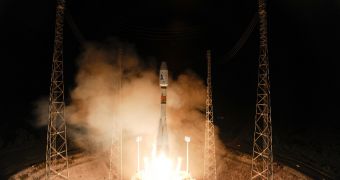Officials with the European Space Agency (ESA) announce that their Gaia space telescope, one of the most ambitious astronomical projects ever developed, was recently able to reach its final science orbit.
The astrometric space observatory was manufactured for ESA by EADS Astrium, and was launched into space aboard a Soyuz-FG medium-lift delivery system on December 19, 2013. The telescope took off from the Kourou Spaceports, in French Guiana, at 0912 UTC.
Since then, the large space telescope has been heading for the Sun–Earth L2 (Lagrange) point, in a Lissajous orbit with a periapsis of 90,000 kilometers (56,000 miles) and an apoapsis of 340,000 kilometers (210,000 miles). This orbital point is located 1.5 million kilometers (930,000 miles) away from Earth.
From this vantage point, Gaia will always maintain its relative position with respect to the Sun-Earth-Moon system, meaning that it will find it easy to block any incoming light pollution. Starting 2018, it will share this orbit with NASA's James Webb Space Telescope.
According to ESA experts, the spacecraft still has to perform an additional course correction maneuver in order to enter its final orbit. L2 is not a proper point in space, but rather a theoretical location.
“Entering orbit around L2 is a rather complex endeavor, achieved by firing Gaia’s thrusters in such a way as to push the spacecraft in the desired direction whilst keeping the Sun away from the delicate science instruments,” says the manager for ESA spacecraft operations at ESA, David Milligan.
“After a beautiful launch from Kourou last month, we are very happy to now have reached our destination, and we are looking forward to starting our science operations in the coming months,” adds the manager of the Gaia project, ESA official Giuseppe Sarri.
The purpose of the telescope is to survey the position of 1 percent of stars in the Milky Way over a 5-year period. That is the equivalent of more than 1 billion stars, which will be surveyed several dozen times each. By studying minute differences in each star's position, experts will be able to use Gaia data to compile a 3D map of stars in the Milky Way.
“Our Gaia discovery machine will keep us busy throughout the mission, with the final results coming only after the five years of data have been analyzed. But it will be well worth the wait, ultimately giving us a new view of our cosmic neighborhood and its history,” concludes Timo Prusti, a Gaia project scientist.

 14 DAY TRIAL //
14 DAY TRIAL //